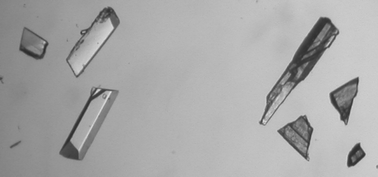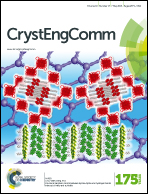Dimorphism of 1,4-dibromo-2,5-bis(bromomethyl)benzene: crystallographic and physico-chemical investigations†
Abstract
Two polymorphic modifications of 1,4-dibromo-2,5-bis(bromomethyl)benzene have been discovered and structurally characterized; their thermodynamic relationships and transformation behaviour have been investigated. Form I crystallizes in the triclinic space group P![[1 with combining macron]](https://www.rsc.org/images/entities/char_0031_0304.gif) , whereas form II crystallizes monoclinic in space group P21/c, both with imposed inversion symmetry of the molecule. Their crystal structures involve layers, in which the molecules are linked by intermolecular Br⋯Br interactions to form similar systems of linked rings. Initial studies involved batches consisting of pure form I or a mixture of I with traces of II (as obtained by chance from the synthesis), but solvent-mediated conversion experiments in various solvents clearly prove that form II is the thermodynamically stable form at room temperature. Thermomicroscopic and heating-rate-dependent DSC measurements show that the melting point of form I is slightly higher than that of form II and that the higher melting polymorph exhibits the lower heat of fusion. Therefore, form I becomes thermodynamically stable at higher temperatures and both forms are related by enantiotropism. This is also in agreement with the density rule, because the low-temperature form II exhibits the higher density. Isothermal annealing of both modifications at different temperatures reveals a thermodynamic transition temperature of about 135 °C, which is in excellent agreement with that of 137.5 °C calculated from the melting temperatures and the heat of fusion of both forms. The high-temperature form can easily be prepared pure by solidification of the melt, which is in agreement with Ostwald's step rule, because form I crystallizes at a temperature where it is thermodynamically metastable. A qualitative energy/temperature diagram is presented.
, whereas form II crystallizes monoclinic in space group P21/c, both with imposed inversion symmetry of the molecule. Their crystal structures involve layers, in which the molecules are linked by intermolecular Br⋯Br interactions to form similar systems of linked rings. Initial studies involved batches consisting of pure form I or a mixture of I with traces of II (as obtained by chance from the synthesis), but solvent-mediated conversion experiments in various solvents clearly prove that form II is the thermodynamically stable form at room temperature. Thermomicroscopic and heating-rate-dependent DSC measurements show that the melting point of form I is slightly higher than that of form II and that the higher melting polymorph exhibits the lower heat of fusion. Therefore, form I becomes thermodynamically stable at higher temperatures and both forms are related by enantiotropism. This is also in agreement with the density rule, because the low-temperature form II exhibits the higher density. Isothermal annealing of both modifications at different temperatures reveals a thermodynamic transition temperature of about 135 °C, which is in excellent agreement with that of 137.5 °C calculated from the melting temperatures and the heat of fusion of both forms. The high-temperature form can easily be prepared pure by solidification of the melt, which is in agreement with Ostwald's step rule, because form I crystallizes at a temperature where it is thermodynamically metastable. A qualitative energy/temperature diagram is presented.


 Please wait while we load your content...
Please wait while we load your content...